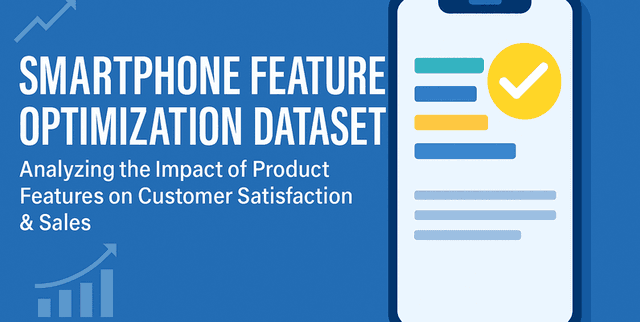Smartphone Feature Optimization (Marketing Mix)
E-commerce & Online Transactions
Tags and Keywords
Trusted By




"No reviews yet"
Free
About
This synthetic but realistic dataset contains 90+ customer reviews for 6 smartphone models (from Apple, Samsung, and Google), along with:
Product specifications (Price, Screen Size, Battery, Camera, RAM, Storage, 5G, Water Resistance)
Customer reviews (Star Ratings, Review Text, Verified Purchase Status)
Sales data (Units Sold per Model)
Potential Use Cases:
✅ Feature importance analysis (Which specs drive ratings?)
✅ Sentiment analysis (NLP on reviews)
✅ Pricing strategy optimization
✅ Market research (Comparing Apple vs. Samsung vs. Google)
Smartphone Customer Satisfaction Survey
Objective: Understand how product features influence purchasing decisions and satisfaction.
Section 1: Demographic & Purchase Behavior
Which smartphone brand did you purchase?
☐ Apple
☐ Samsung
☐ Google
Maps to brand column.
Which model did you purchase?
Apple: ☐ iPhone 14 | ☐ iPhone 15
Samsung: ☐ Galaxy S22 | ☐ Galaxy S23
Google: ☐ Pixel 7 | ☐ Pixel 8
Maps to model_name column.
Where did you purchase the phone?
☐ Online (e.g., Amazon, Brand Website)
☐ Physical Store
Justifies verified_purchase (assumed online = verified).
Section 2: Product Feature Ratings
How would you rate the following features? (1 = Poor, 5 = Excellent)
Battery Life: ⭐⭐⭐⭐⭐
Camera Quality: ⭐⭐⭐⭐⭐
Screen Size: ⭐⭐⭐⭐⭐
Performance (RAM/Processor): ⭐⭐⭐⭐⭐
Aggregates into star_rating (average of these).
Which feature is MOST important to you?
☐ Battery Life
☐ Camera Quality
☐ Screen Size
☐ Performance
☐ Price
Explains review_text keywords (e.g., "battery" mentions).
Section 3: Price & Satisfaction
How do you feel about the price of your phone?
☐ Very Affordable
☐ Fairly Priced
☐ Slightly Expensive
☐ Too Expensive
Maps to price vs. star_rating correlation.
Would you recommend this phone to others?
☐ Definitely Yes ☐ Probably Yes ☐ Neutral ☐ Probably No ☐ Definitely No Linked to star_rating (5 = Definitely Yes).
Column Details (Metadata)
Column Name (Type) Description "Example"**
model_id (Integer) Unique ID for each phone model 1 (iPhone 14)
brand (String) Manufacturer (Apple, Samsung, Google) "Apple"
model_name (String) Name of the phone model "iPhone 15"
price (Integer) Price in USD 999
screen_size (Float) Screen size in inches 6.1
battery (Integer) Battery capacity in mAh 4000
camera_main (String) Main camera resolution (MP) "48MP"
ram (Integer) RAM in GB 8
storage (Integer) Storage in GB 128
has_5g (Boolean) Whether the phone supports 5G TRUE
water_resistant (String) Water resistance rating (IP68 or None) "IP68"
units_sold (Integer) Estimated units sold (for market analysis) 15000
review_id (Integer) Unique ID for each review 1
user_name (String) Randomly generated reviewer name "John"
star_rating (Integer) Rating from 1 (worst) to 5 (best) 5
verified_purchase (Boolean) Whether the reviewer bought the product TRUE
review_date (Date) Date of the review (YYYY-MM-DD) "2023-05-10"
review_text (String) Simulated review text based on features & rating "The 48MP camera is amazing!"
Suggested Analysis Ideas to inspire data analysis:
A. Feature Impact on Ratings
Regression: star_rating ~ battery + camera_main + price
Key drivers: Does battery life affect ratings more than camera quality?
B. Sentiment Analysis (NLP)
Use tidytext (R) or NLTK (Python) to extract most-loved/hated features.
Example:
r
library(tidytext)
reviews_tidy <- final_data %>% unnest_tokens(word, review_text)
reviews_tidy %>% count(word, sort = TRUE) %>% filter(n > 5)
C. Brand Comparison
Apple vs. Samsung vs. Google: Which brand has higher average ratings?
Price sensitivity: Do cheaper phones (e.g., Pixel) get better value ratings?
D. Sales vs. Features
Correlation: units_sold ~ price + brand
Premium segment analysis: Do iPhones sell more despite higher prices?
License
CC0
Original Data Source: Smartphone Feature Optimization (Marketing Mix)
